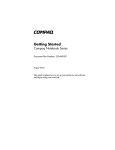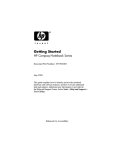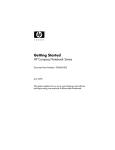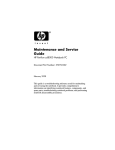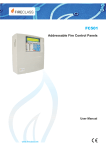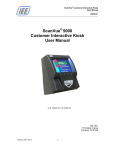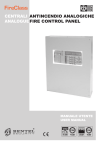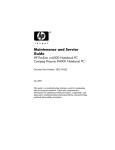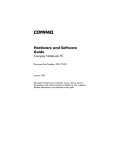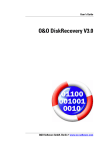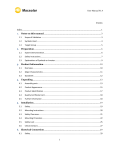Download HP COMPAQ BUSINESS NOTEBOOK SERIES 376311-001 User's Manual
Transcript
Getting Started HP Compaq Business Notebook Series Document Part Number: 376311-001 November 2004 This guide explains how to set up your notebook hardware and software and begin using your notebook. Enhanced for Accessibility. © Copyright 2004 Hewlett-Packard Development Company, L.P. Microsoft and Windows are U.S. registered trademarks of Microsoft Corporation. SD Logo is a trademark of its proprietor. The information contained herein is subject to change without notice. The only warranties for HP products and services are set forth in the express warranty statements accompanying such products and services. Nothing herein should be construed as constituting an additional warranty. HP shall not be liable for technical or editorial errors or omissions contained herein. Getting Started HP Compaq Business Notebook Series First Edition November 2004 Reference Number: nx9600 Document Part Number: 376311-001 Contents 1 Hardware Setup Step 1: Identify the Setup Hardware . . . . . . . . . . . . . . . . 1–2 Step 2: Insert the Battery Pack . . . . . . . . . . . . . . . . . . . . . 1–4 Step 3: Connect the Modem . . . . . . . . . . . . . . . . . . . . . . . 1–5 Connecting the Modem to an RJ-11 Jack . . . . . . . . . 1–6 Connecting the Modem with an Adapter. . . . . . . . . . 1–7 Step 4: Open the Notebook . . . . . . . . . . . . . . . . . . . . . . . 1–8 Step 5: Connect the Notebook to External Power . . . . . . 1–9 Step 6: Charge the Battery Pack. . . . . . . . . . . . . . . . . . . 1–10 Step 7: Turn On the Notebook . . . . . . . . . . . . . . . . . . . . 1–11 2 Software Setup Welcome to Microsoft Windows . . . . . . . . . . . . . . . . . . . Select Your Regional Preferences . . . . . . . . . . . . . . . . . . Accept the End-User License Agreements . . . . . . . . . . . Help Protect Your Notebook . . . . . . . . . . . . . . . . . . . . . . Name Your Notebook . . . . . . . . . . . . . . . . . . . . . . . . . . . Register Online. . . . . . . . . . . . . . . . . . . . . . . . . . . . . . . . . Create User Accounts. . . . . . . . . . . . . . . . . . . . . . . . . . . . Press the Finish Button. . . . . . . . . . . . . . . . . . . . . . . . . . . 2–2 2–4 2–5 2–6 2–7 2–8 2–9 2–9 3 Next Steps Protect Your Notebook . . . . . . . . . . . . . . . . . . . . . . . . . . Protect the Notebook from Viruses . . . . . . . . . . . . . . Protect Your System Files . . . . . . . . . . . . . . . . . . . . . Protect Your Privacy . . . . . . . . . . . . . . . . . . . . . . . . Getting Started 3–1 3–2 3–3 3–4 iii Contents Protect the Notebook from Power Surges . . . . . . . . . 3–6 Use the Notebook Safely . . . . . . . . . . . . . . . . . . . . . . 3–7 Turn Off the Notebook Properly . . . . . . . . . . . . . . . . 3–8 Connect to the Internet . . . . . . . . . . . . . . . . . . . . . . . . . . . 3–9 Enable Communication Hardware. . . . . . . . . . . . . . . 3–9 Set Up Internet Service . . . . . . . . . . . . . . . . . . . . . . 3–10 Preview the Help and Support Guide. . . . . . . . . . . . . . . 3–12 4 Notebook Tour Top Components . . . . . . . . . . . . . . . . . . . . . . . . . . . . . . . 4–2 TouchPad . . . . . . . . . . . . . . . . . . . . . . . . . . . . . . . . . . 4–2 Keys . . . . . . . . . . . . . . . . . . . . . . . . . . . . . . . . . . . . . . 4–4 Power Control . . . . . . . . . . . . . . . . . . . . . . . . . . . . . . 4–5 Lights . . . . . . . . . . . . . . . . . . . . . . . . . . . . . . . . . . . . . 4–6 Buttons. . . . . . . . . . . . . . . . . . . . . . . . . . . . . . . . . . . . 4–7 Front Components . . . . . . . . . . . . . . . . . . . . . . . . . . . . . . 4–8 Rear Components . . . . . . . . . . . . . . . . . . . . . . . . . . . . . . . 4–9 Connectors, Jacks and Ports . . . . . . . . . . . . . . . . . . . 4–9 Vent . . . . . . . . . . . . . . . . . . . . . . . . . . . . . . . . . . . . . 4–10 Left-Side Components . . . . . . . . . . . . . . . . . . . . . . . . . . 4–11 Connectors, Jacks and Components . . . . . . . . . . . . 4–11 Vent . . . . . . . . . . . . . . . . . . . . . . . . . . . . . . . . . . . . . 4–12 Right-Side Components . . . . . . . . . . . . . . . . . . . . . . . . . 4–13 Bottom Components. . . . . . . . . . . . . . . . . . . . . . . . . . . . 4–15 Bays and Memory Compartment. . . . . . . . . . . . . . . 4–15 Vents . . . . . . . . . . . . . . . . . . . . . . . . . . . . . . . . . . . . 4–16 Additional Standard Components . . . . . . . . . . . . . . . . . 4–17 Cables and Cord. . . . . . . . . . . . . . . . . . . . . . . . . . . . 4–18 Adapters and Battery Pack . . . . . . . . . . . . . . . . . . . 4–19 Labels. . . . . . . . . . . . . . . . . . . . . . . . . . . . . . . . . . . . 4–20 Restoration and Documentation Discs . . . . . . . . . . 4–21 Index iv Getting Started 1 Hardware Setup Ä CAUTION: To prevent file corruption and ensure that the correct drivers are installed: ■ Do not set up the notebook for the first time while the notebook is connected to an optional expansion product. ■ During the hardware and software setup procedures: ❏ Do not unplug the notebook from external power. ❏ Do not shut down the notebook or initiate Standby mode or Hibernation mode. ❏ Do not insert, remove, connect, or disconnect any device, cable, or cord, unless instructed to do so. During hardware setup, you will 1. Identify the hardware you need to set up the notebook. 2. Insert the battery pack into the notebook. 3. Connect the modem, so you can register the notebook and operating system during software setup. 4. Open the notebook. 5. Connect the notebook to external power. 6. Allow the battery pack to charge. 7. Turn on the notebook. When the notebook is turned on, you will be prompted to begin software setup. Getting Started 1–1 Hardware Setup Step 1: Identify the Setup Hardware To set up the notebook for the first time, you need the notebook and the components listed in the following table. cords, AC adapters, modem cables, and modem adapters ✎ Power may vary in appearance. Component Description 1 Connects the modem to a telephone jack or to a country-specific modem adapter. Modem cable (included with select models) modem cable has a 6-pin ✎ ARJ-11 telephone connector at each end. 2 Power cord Connects the AC adapter to an AC outlet. (Continued) 1–2 Getting Started Hardware Setup Component Description 3 AC adapter Converts AC power to DC power. 4 Network cable (not included) Connects the notebook to a network jack. network cable has an 8-pin ✎ ARJ-45 network connector at each end. 5 Country-specific modem adapter (included by region as required) Adapts the modem cable to a non-RJ-11 telephone jack. 6 Battery pack Provides power to the notebook when the notebook is not connected to external power. Getting Started 1–3 Hardware Setup Step 2: Insert the Battery Pack Ä CAUTION: To avoid data loss when you turn on the notebook, make sure the battery pack is firmly seated. Ä CAUTION: To ensure that the correct drivers load and to prevent file corruption or damage to components, do not remove the battery pack until the notebook has been connected to external power. To insert the battery pack: 1. Turn the notebook upside down on a flat surface. 2. Insert the alignment tab on the battery pack into the alignment slot on the notebook 1. 3. Tilt the battery pack downward until it snaps into place 2. 1–4 Getting Started Hardware Setup Step 3: Connect the Modem Å WARNING: To reduce the risk of electric shock, disconnect the modem from the telephone network before accessing an internal compartment of the notebook. Internal compartments include the memory compartment, the battery bay, and the hard drive bay. To connect the modem so that you can register your notebook and operating system during software setup: ■ Follow the instructions in this section for connecting the modem to an analog telephone line. – or – ■ Follow the instructions provided by your Internet service provider (ISP) to connect the notebook to the Internet through a DSL (Digital Subscriber Line) modem, cable modem, or network connection. For more information about DSL, cable, and network connections, select Start > Help and Support. The Help and Support utility provides hardware and software information, instructions, tutorials, and wizards that can help you set up or troubleshoot a variety of connections. to connect your modem to a telephone line ✎ Itnowmayandbeseteasier up another Internet connection later, after you have completed software setup. Wall jacks for analog telephone lines vary by country. ■ If you are connecting the modem to a telephone line in a country where RJ-11 telephone wall jacks are standard, see the following section “Connecting the Modem to an RJ-11 Jack.” ■ If you are connecting the modem to a telephone line in a country where RJ-11 telephone wall jacks are not standard, see the section “Connecting the Modem with an Adapter,” later in this chapter. Getting Started 1–5 Hardware Setup Connecting the Modem to an RJ-11 Jack To connect the modem to an analog telephone line that has an RJ-11 telephone jack: 1. Turn the notebook display-side up on a flat surface near an RJ-11 telephone wall jack. 2. If your modem cable has noise suppression circuitry 1, which prevents interference with TV and radio reception, place the circuitry end of the cable near the notebook. 3. Plug the modem cable into the RJ-11 (modem) jack on the notebook 2. 4. Plug the other end of the modem cable into the RJ-11 telephone wall jack 3. wall jacks and modem cables vary in appearance by ✎ Telephone region and country. 1–6 Getting Started Hardware Setup Connecting the Modem with an Adapter To connect the modem to an analog telephone line that does not have an RJ-11 telephone wall jack: 1. Turn the notebook display-side up on a flat surface near a telephone wall jack. 2. If your modem cable has noise suppression circuitry 1, which prevents interference with TV and radio reception, place the circuitry end of the cable near the notebook. 3. Plug the modem cable into the RJ-11 (modem) jack on the notebook 2. 4. Plug the other end of the modem cable into the country-specific modem adapter 3. 5. Plug the country-specific modem adapter into the telephone wall jack 4. wall jacks, modem adapters, and modem cables ✎ Telephone vary in appearance by region and country. Getting Started 1–7 Hardware Setup Step 4: Open the Notebook To open the notebook: 1. Place the notebook display-side up on a flat surface near an electrical outlet. 2. Press the display release button 1, and then lift the display 2. 1–8 Getting Started Hardware Setup Step 5: Connect the Notebook to External Power To connect the notebook to external power: 1. Plug the AC adapter cable into the power connector 1. 2. Plug the power cord into the AC adapter 2, and then into an electrical outlet 3. The battery light is turned on and the battery pack begins to charge. cords, AC adapters, and electrical outlets may vary in ✎ Power appearance. Getting Started 1–9 Hardware Setup Step 6: Charge the Battery Pack The battery pack begins to charge as soon as the notebook is connected to external power. Charge status is indicated by the battery light, which remains on while the battery pack is charging. The battery light is on while the battery pack is charging. It is recommended that you leave the notebook connected to external power until the battery pack is fully charged and the battery light is turned off. A partially charged new battery pack can run the notebook, but battery charge displays will not be accurate until the new battery pack has been fully charged. 1–10 Getting Started Hardware Setup Step 7: Turn On the Notebook To turn on the notebook: » Press the power/standby button 1. The power/standby button light and the power/standby light on the front of the notebook 2 are turned on and you are prompted to begin software setup. power/standby button light and the power/standby light ✎ The display the same information. The power/standby button light is visible only when the notebook is open; the power/standby light is visible when the notebook is open or closed. Getting Started 1–11 Hardware Setup If the notebook does not power up: ■ Make sure the AC adapter is securely plugged into the notebook and an electrical outlet. ■ Make sure the electrical outlet is providing power. (To confirm that the outlet is providing power, plug another device into the outlet.) ■ If you have installed a battery pack, make sure the battery pack is firmly seated. ■ Refer to the Worldwide Telephone Numbers booklet (English only) included with the notebook to contact Customer Care. 1–12 Getting Started 2 Software Setup During software setup you can ■ Select regional preferences. ■ Accept license agreements. ■ Name your notebook. ■ Register online. ■ Create user accounts. If you prefer not to register your notebook during software setup, you can do so at any time after software setup is complete. You can also change or add any settings you select or skip during the setup process. For instructions, refer to Chapter 2, “Managing Your Software,” in the Help and Support Guide included with your notebook. Although you can register and set preferences later, it is usually easier and faster to complete these tasks during software setup. Getting Started 2–1 Software Setup Software setup begins when you respond to the setup prompt on the notebook screen. Ä CAUTION: If you are prompted to select an operating system language before the Welcome to Microsoft Windows window is displayed, choose carefully. On some models, the languages that you do not choose are deleted from the system and cannot be restored during software setup. ■ After you respond to the setup prompt, you must complete the entire setup process without interruption. Setup time varies. ■ During software setup, it is normal for some notebook models to pause occasionally for several minutes. These pauses are indicated by an hourglass icon. Welcome to Microsoft Windows The first window in software setup is Welcome to Microsoft Windows. This window welcomes you to your Microsoft® Windows® operating system and introduces you to software setup navigation: ■ To display additional information about the text in any setup window: Select the question mark icon in the lower-right section of the window or press the f1 key on your keyboard. ■ To continue to the next window: Select the Next button in the lower-right corner of the window. 2–2 Getting Started Software Setup ■ To return to the previous window: Select the Back button in the lower-left corner of the window. (This button is unavailable on the first window, Welcome to Microsoft Windows.) ■ To skip a window without entering a preference: Select the Skip button in the lower-right corner of the window. (This button is unavailable on some windows.) To navigate in a window: » Slide your finger on the TouchPad 1 in the direction that you want to move the pointer. To select an item: » Move the pointer over the item, and press the left TouchPad button 2. Getting Started 2–3 Software Setup Select Your Regional Preferences The next 2 windows prompt you to confirm or select regional preferences. Regional preferences are preset for the country in which you purchased the notebook. ■ Dates and currency window—The operating system will format dates and currency according to the region and language preferences you confirm or select in the How should dates and currency appear? window. Notice that some languages include regional versions. The versions are shown in parentheses after the language name. ■ Time zone window—The operating system will set the notebook clock according to the time zone you confirm or select in the What time zone are you in? window. Notice that you can select a check box to set the notebook clock to adjust to daylight saving time. 2–4 Getting Started Software Setup Accept the End-User License Agreements In the End-User License Agreement window, you must accept both the Microsoft End-User License Agreement and the HP Software Product License Agreement to continue with software setup. ■ To accept both agreements: Select Yes, I accept them, and then select Next. ■ To decline both agreements: Select No, I don’t accept them, and the select Next. If you decline both agreements, you will not be permitted to use the installed software. On the following screen, you will be offered only 2 options: You can choose Back to return to the End-User License Agreement window or choose Shutdown to turn off the notebook. When you start the notebook after selecting Shutdown, the Welcome to Microsoft Windows window is displayed and you must begin software setup again. Getting Started 2–5 Software Setup Help Protect Your Notebook In the Help protect your PC window, you can choose to have your notebook automatically download and install Windows updates as they become available. The Automatic Updates feature helps protect your notebook by providing important security enhancements. It is strongly recommended that you enable this feature. To enable Automatic Updates: » Select the Help protect my PC by turning on Automatic Updates now radio button. If you do not choose to enable Automatic Updates, it is strongly recommended that you use the Windows Updates feature on a regular basis to check for critical updates. For more information, select Start > Help and Support. 2–6 Getting Started Software Setup Name Your Notebook If you plan to include your notebook on a home network, your notebook must have a unique name. In the What’s your computer’s name? window, you can retain the default name shown in the Computer name text field or choose another name. For example, you may want to base your notebook name on a person’s name, “David,” or a location, “Familyroom.” In order for your notebook name to be displayed on a network, the name ■ Must be no longer than 15 characters. ■ Must include only letters (A-Z and a-z), numerals (0-9), and hyphens. ■ Cannot include spaces. If you like, you can also enter a description of your notebook. The description may contain more characters than the notebook name, as well as spaces and special characters. For example, you could describe your notebook as “David’s game machine.” Getting Started 2–7 Software Setup Register Online In the Register Online with Hewlett-Packard window, you can ■ Register your notebook—Complete the text fields. ■ Register your operating system—Select the Also Register with Microsoft check box beneath the text fields. ■ Indicate how you would like to be contacted by Hewlett-Packard—Select or clear the check boxes above the Microsoft registration information. ■ View privacy statements: ❏ To view the Hewlett-Packard Registration Privacy Statement, select the underlined link near the top of the window. ❏ To view the Microsoft Windows Registration Privacy Statement, select the underlined link near the bottom of the window. If you connected your modem during the hardware setup in Chapter 1, “Hardware Setup,” or have connected the notebook to the Internet by another method, the Connecting to online registration window is displayed. This window describes the progress of your registration. If you are unable to send your registration, you can do so at any time after software setup is complete. 2–8 Getting Started Software Setup Create User Accounts In the Who will use this computer? window, you can create a user account for each person who may use the notebook. User accounts enable each notebook user to create a personal notebook environment. A user’s environment may include such customizations as display and security settings, personal files, screen savers, and the appearance of the Windows desktop. When you start or restart the notebook, a prompt to select a user account is displayed. When a user account is selected, Windows opens according to the preferences set by that user. The names you enter in the text fields of the Who will use this computer? window are displayed at Windows startup on the list of user accounts. Press the Finish Button When the Thank you! window is displayed: 1. Read the text, and then select Finish. (Your notebook saves your preferences, and then restarts in Windows.) 2. Select your user account. (You are ready to begin using your notebook.) protect your notebook and gain Internet access to software ✎ Toupdates and online assistance, it is recommended that you follow the suggestions in Chapter 3, “Next Steps.” Getting Started 2–9 3 Next Steps software instructions in your notebook documentation ✎ All describe Microsoft® Windows® XP procedures based on the default Windows XP category view. For information about switching between Windows XP classic view and Windows XP category view, select Start > Help and Support > Customizing your computer > Files, folders, and programs > Use Windows classic folders. Protect Your Notebook You can use the information in this section to ■ Protect your notebook from viruses. ■ Protect your system files. ■ Protect your privacy. ■ Protect your notebook from power surges. ■ Use your notebook safely. ■ Turn off your notebook properly. For information about other notebook security features, such as passwords, device disabling, and using an optional security cable lock, refer to the “Security” chapter in the Hardware and Software Guide on the Notebook Documentation CD. Getting Started 3–1 Next Steps Protect the Notebook from Viruses When you use the notebook for e-mail, network, or Internet access, you expose the notebook to computer viruses. Computer viruses can disable your operating system, applications, or utilities or cause them to function abnormally. Antivirus software can detect most viruses, destroy them, and in most cases, repair damage they have caused. To provide protection against newly discovered viruses, antivirus software must be updated. Norton AntiVirus is preinstalled on your notebook. For information about using and updating your Norton AntiVirus software: » Select Start > All Programs > Norton AntiVirus >Help and Support. For more information about computer viruses: 1. Select Start > Help and Support. 2. Type viruses into the Search text field. 3. Press enter. 3–2 Getting Started Next Steps Protect Your System Files System Restore is an operating system feature that enables you to undo harmful changes to your notebook software by restoring your software to an earlier time, called a restore point, when your software was functioning optimally. Restore points are restorable, benchmark “snapshots” of your application, driver, and operating system files. The notebook sets restore points at regular intervals and may set additional restore points whenever you change your personal settings or add software or hardware. Manually setting additional restore points provides additional protection for your system files and settings. It is recommended that you manually set restore points ■ Before you add or extensively modify software or hardware. ■ Periodically, whenever the system is performing optimally. Restoring to any restore point does not affect your data files. For example, restoring your system software to an earlier time will not affect documents or e-mails that you saved after that time. All System Restore procedures are reversible. Setting a Restore Point To set a system restore point manually: 1. Select Start > Help and Support > System Restore. 2. Select Create a restore point, and then follow the instructions on the screen. Getting Started 3–3 Next Steps Restoring to a Restore Point To restore the notebook to a restore point: 1. Make sure the notebook is connected to reliable external power through the AC adapter. 2. Select Start > Help and Support > System Restore. 3. Select Restore my computer to an earlier time, and then follow the instructions on the screen. Protect Your Privacy When you use the notebook for e-mail, network, or Internet access, it is possible for unauthorized persons to obtain information about you, your notebook, and your data. To optimize the privacy protection features included with your notebook, it is recommended that you ■ Keep your Windows operating system updated. ■ Use a firewall. For details, see the following sections “Critical Security Updates for Windows XP” and “Firewall Software.” 3–4 Getting Started Next Steps Critical Security Updates for Windows XP Ä CAUTION: Because new computer viruses are being detected all the time, it is recommended that you install all critical updates as soon as you receive an alert from Microsoft. You should also run Windows Update on a monthly basis to install the latest recommended updates from Microsoft. A Critical Security Updates for Windows XP disc may have been included with your notebook to provide additional updates delivered after the computer was configured. Throughout the life of the computer, Microsoft will continue to update the operating system and make these updates available on their Web site. To update your system using the Critical Security Updates for Windows XP disc: 1. Insert the disc into the drive. (The disc automatically runs the installation application.) 2. Follow the on-screen instructions to install all updates. (This may take a few minutes.) 3. Remove the disc. Getting Started 3–5 Next Steps Firewall Software When you use the notebook for e-mail, network, or Internet access, it is possible for unauthorized persons to obtain information about you, your notebook, and your data. Firewalls monitor all incoming and outgoing traffic on your computer by including features such as logging and reporting, automatic alarms, and user interfaces for configuring the firewall. To protect your privacy, it is recommended that you use firewall software. Your notebook comes with preinstalled firewall software. Refer to the online Help in the firewall software application for additional information. some circumstances a firewall can block access to ✎ Under Internet games, interfere with printer or file sharing on a network, or block authorized e-mail attachments. To temporarily solve the problem, disable the firewall, perform the task that is interfering with the firewall, and then reenable the firewall. To permanently resolve the problem, reconfigure the firewall. Protect the Notebook from Power Surges To protect the notebook from the power surges that may be caused by an uncertain power supply or an electrical storm: ■ Plug the notebook power cord into an optional, high-quality surge protector. Surge protectors are available from most computer or electronics retailers. ■ Provide surge protection on the cable that connects the modem to a telephone line. ■ During an electrical storm, either run the notebook on battery power or shut down the notebook and disconnect the power cord. 3–6 Getting Started Next Steps Use the Notebook Safely Å WARNING: To reduce the risk of electric shock or damage to your equipment: ■ Plug the power cord into an electrical outlet that is easily accessible at all times. ■ To disconnect power from the notebook, unplug the power cord from the electrical outlet. ■ If provided with a three-pin attachment plug on your power cord, plug the cord into a grounded (earthed) three-pin outlet. Do not disable the power cord grounding pin; for example, by using a 2-pin adapter. The grounding pin is an important safety feature. Å WARNING: To reduce the risk of serious injury, read the Safety and Comfort Guide. It describes proper workstation setup, and proper posture, health, and work habits for computer users. The Safety and Comfort Guide also provides important electrical and mechanical safety information. This guide is located on the Web at http://www.hp.com/ergo, on the notebook hard drive, and on the Notebook Documentation CD that is included with the product. Å WARNING: This notebook is designed to run demanding applications at full power. As a result of increased power consumption, it is normal for the notebook to feel warm or hot when used continuously. To avoid potential discomfort or burns, do not block the air vents or use the notebook on your lap for extended periods. The notebook complies with the user-accessible surface temperature limits defined by the International Standard for Safety of Information Technology Equipment (IEC 60950). For more safety and regulatory information, refer to the Regulatory and Safety Notices on the Notebook Documentation CD and to the printed Wireless Regulatory Notices document included with your notebook. Getting Started 3–7 Next Steps Turn Off the Notebook Properly Whenever possible, turn off the notebook by using the standard Windows shutdown procedure for your operating system. To turn off the notebook: » Select Start > Turn Off Computer > Turn Off. If the notebook does not respond, try the following emergency shutdown procedures in the order shown: ■ Press ctrl+alt+delete, select Shut Down, and then select Turn Off from the drop-down list. ■ Press and hold down the power/standby button for at least 4 seconds. ■ Unplug the notebook from external power by unplugging the power cord from the electrical outlet. Then remove the battery pack. For instructions on removing the battery pack, refer to the Hardware and Software Guide on the Notebook Documentation CD. 3–8 Getting Started Next Steps Connect to the Internet To connect the notebook to the Internet, you must enable your communication hardware and have an account with an Internet service provider (ISP). Enable Communication Hardware Your modem is enabled when the modem cable is connected to the notebook and to an analog telephone line. ■ If you connected the modem cable during hardware setup, your modem is enabled. Proceed to the following section, “Set Up Internet Service.” ■ If you did not connect the modem cable during hardware setup: 1. Turn off your notebook. 2. Follow the instructions in the section “Step 3: Connect the Modem” in Chapter 1. 3. Turn on your notebook and log on to Windows. 4. Refer to the following section, “Set Up Internet Service.” To enable a wireless device, refer to the printed Go Wireless document included with your notebook (select models only). For more information about modem, wireless, cable, DSL and network connections, select Start > Help and Support. The Help and Support utility provides hardware and software information, instructions, tutorials, and wizards that can help you set up or troubleshoot a variety of connections. Getting Started 3–9 Next Steps Set Up Internet Service You must set up Internet service before you can connect to the Internet. Arrangements have been made with leading ISPs in many locations to help you set up a new Internet account or to configure your notebook to use an existing account. Depending on your location, you may be able to set up Internet service by using the Easy Internet Sign-up utility or an ISP-provided icon on your desktop. In all locations, you can set up Internet service by using the Windows Internet Connection wizard. Using Easy Internet Sign-Up If the Easy Internet Sign-Up utility is supported in the country in which you purchased your notebook, you can access the utility by using either of the following methods: » Double-click the Easy Internet Sign-up icon on the desktop. – or – » Select Start > All Programs > Online Services > Easy Internet Sign-up. If the Easy Internet Sign-Up utility is available, you can use the utility to ■ Sign up for a new Internet account. ■ Configure your notebook to use an existing account. ■ Learn about accessing the Internet through a LAN (local area network), cable, or DSL connection. If you plan to use a LAN, DSL, or cable Internet connection, you may need to contact your ISP for information about obtaining additional software or hardware. For more information about LAN, DSL or cable Internet connections, select Start > Help and Support. 3–10 Getting Started Next Steps If the Easy Internet Sign-Up utility is not available, see the following sections, “Using an ISP-Provided Icon” or “Using the Internet Connection Wizard.” Using an ISP-Provided Icon If ISP-provided icons are supported in the country in which you purchased your notebook, the icons may be displayed either individually on the Windows desktop or grouped in a desktop folder named Online Services. To set up a new Internet account or configure your notebook to use an existing account, double-click an icon, and then follow the instructions on the screen. Using the Internet Connection Wizard You can use the Windows Internet Connection wizard to connect to the Internet ■ If you already have an account with an ISP. ■ If you have a CD from an ISP. ■ If you do not have an Internet account and would like to select an ISP from the list provided within the wizard. (The list of ISP providers is not available in all regions.) ■ If you have selected an unlisted ISP and the ISP has provided you with such information as a specific IP address, and POP3 and SMTP settings. To access the Internet Connection wizard and instructions for using the wizard: 1. Select Start > Help and Support. 2. In the Search text field, type Make an Internet connection. 3. Select Search. Getting Started 3–11 Next Steps Preview the Help and Support Guide The Help and Support Guide included with your notebook contains ■ Information about the interactive Help and Support utility and the Notebook Documentation CD. ■ Instructions for updating your operating system, adding or changing any settings you skipped or entered during software setup, and setting additional preferences. ■ Instructions for installing additional software. ■ Tips for quick troubleshooting. ■ Procedures for repairing or reinstalling your drivers, operating system, and other preinstalled software. By previewing the Help and Support Guide now, you will know how to find any information or help you may need later. 3–12 Getting Started 4 Notebook Tour This chapter identifies the visible hardware features of your notebook. To find out how to use a feature, such as hotkeys, or to find out about a general topic, such as Standby or Hibernation, refer to the Hardware and Software Guide on the Notebook Documentation CD. Getting Started 4–1 Notebook Tour Top Components TouchPad Component Description 1 TouchPad light On: TouchPad is enabled. 2 TouchPad* Moves the pointer and selects or activates items on the screen. 3 Left and right TouchPad buttons (2)* Function like the left and right buttons on an external mouse. 4 TouchPad left/right scroll zone* Scrolls left or right. (Continued) 4–2 Getting Started Notebook Tour Component Description 5 TouchPad up/down scroll zone* Scrolls up or down. 6 TouchPad button Enables/disables the TouchPad. *This table describes default settings. For information about changing the functions of TouchPad features, refer to the Hardware and Software Guide on the Notebook Documentation CD. Getting Started 4–3 Notebook Tour Keys 4–4 Component Description 1 Function keys Perform system and application tasks. When combined with the fn key, the function keys perform additional tasks as hotkeys. For more information, refer to the Hardware and Software Guide on the Notebook Documentation CD. 2 fn key Combines with other keys to perform system tasks, and activates hotkeys. For example, pressing fn+f8 increases screen brightness. 3 Windows logo key Displays the Windows Start menu. 4 Windows applications key Displays a shortcut menu for items beneath the pointer. 5 Keypad keys (17) Standard numeric keypad. Getting Started Notebook Tour Power Control Component Description Power/standby button* When the notebook is ■ Off, press to turn on the notebook. ■ On, briefly press to initiate Hibernation. ■ In Standby, briefly press to resume from Standby. ■ In Hibernation, briefly press to restore from Hibernation. the system has stopped ✎ Ifresponding and Windows shutdown procedures cannot be used, press and hold the power/standby button for at least 4 seconds to turn off the notebook. *This table describes default settings. For information about changing the function of the power/standby button or display switch, refer to the Hardware and Software Guide on the Notebook Documentation CD. Getting Started 4–5 Notebook Tour Lights Component Description 1 Caps lock light On: Caps lock is on. 2 Num lock light On: Num lock or the numeric keypad is on. 3 Wireless light On: An integrated wireless device has been enabled (select models only). 4–6 Getting Started Notebook Tour Buttons Component Description 1 Volume down button Decreases system volume. 2 Volume up button Increases system volume. 3 Volume mute button Mutes or restores system volume. 4 Wireless button Turns the wireless network device on and off (select models only). Getting Started 4–7 Notebook Tour Front Components 4–8 Component Description 1 Display release button Opens the notebook. 2 Stereo speakers (2) Produce stereo sound. 3 Wireless light On: An integrated wireless device has been enabled (select models only). 4 Power/standby light On: Notebook is turned on. Blinking: Notebook is in Standby. 5 IDE (Integrated Drive Electronics) drive light On: Internal hard drive or optical drive is being accessed. 6 Battery light On: Battery pack is charging. Blinking: Battery pack has reached a low-battery condition. Getting Started Notebook Tour Rear Components Connectors, Jacks and Ports Component Description 1 Power connector Connects an AC adapter. 2 USB port Connects an optional 1.1- or 2.0-compliant USB device. 3 S-Video-out jack Connects an optional S-Video device, such as a television, VCR, camcorder, projector, or video capture card. 4 External monitor port Connects an optional VGA external monitor or projector. 5 Security cable slot Attaches an optional security cable to the notebook. Getting Started 4–9 Notebook Tour Vent Component Description Exhaust vent Provides airflow to cool internal components. Ä 4–10 To prevent overheating, do not obstruct vents. Do not allow a hard surface, such as a printer, or a soft surface, such as a pillow, blanket, rug, or thick clothing, to block airflow. Getting Started Notebook Tour Left-Side Components Connectors, Jacks and Components Component Description 1 USB port Connects an optional 1.1- or 2.0-compliant USB device. 2 Audio-in (microphone) jack Connects an optional monaural microphone. 3 Audio-out (headphone) jack Connects optional headphones or powered stereo speakers. Also connects the audio function of an audio/video device such as a television or VCR. 4 Optical drive* Supports an optical disc. 5 Optical drive release button Opens the optical drive. *The type of optical drive, such as a combination CD-ROM/DVD-ROM, varies by model. Getting Started 4–11 Notebook Tour Vent Component Description Exhaust vent Provides airflow to cool internal components. Ä 4–12 To prevent overheating, do not obstruct vents. Do not allow a hard surface, such as a printer, or a soft surface, such as a pillow, blanket, rug, or thick clothing, to block airflow. Getting Started Notebook Tour Right-Side Components Component Description 1 Digital Media Slot Supports the following optional digital cards: SD (Secure Digital) Memory Card, SD I/O Card, Memory Stick, Memory Stick Pro, MultiMediaCard, xD-Picture Card, and SmartMedia card. 2 PC Card eject button Ejects an optional PC Card from the PC Card slot. 3 PC Card slot Supports an optional Type I or Type II 32-bit (CardBus) or 16-bit PC Card. 4 ExpressCard slot Supports an optional ExpressCard. 5 Digital drive bay Supports an optional HP USB Digital Drive. (Continued) Getting Started 4–13 Notebook Tour Component Description 6 Digital drive eject button Ejects an optional HP USB Digital Drive from the digital drive bay. 7 USB ports (2) Connect optional 1.1- or 2.0-compliant USB devices. 8 1394 port Connects an optional 1394 device, such as a camcorder. 9 RJ-11 (modem) jack Connects a modem cable. (Included with select models.) - RJ-45 (network) jack Connects a network cable. (A network cable is included with select models.) q Expansion port 2* Connects to an optional notebook expansion product. For more information, refer to the Hardware and Software Guide on the Notebook Documentation CD. *The notebook has only one expansion port. The term expansion port 2 describes the type of expansion port. 4–14 Getting Started Notebook Tour Bottom Components Bays and Memory Compartment Component Description 1 Memory compartment Contains 2 memory slots. Depending on the model, when the notebook is shipped, either one or both memory slots are filled with a replaceable memory module. 2 Battery pack release latch Releases a battery pack from the battery bay. 3 Battery bay Holds a battery pack. 4 Hard drive bay Holds the internal hard drive. Getting Started 4–15 Notebook Tour Vents Component Description Vents (8) Provide airflow to cool internal components. Ä 4–16 To prevent overheating, do not obstruct vents. Do not allow a hard surface, such as a printer, or a soft surface, such as a pillow, blanket, rug, or thick clothing, to block airflow. Getting Started Notebook Tour Additional Standard Components The components included with the notebook vary by region, country, notebook model, and the optional hardware ordered. The following sections identify the standard external accessories and components included with most notebook models. Getting Started 4–17 Notebook Tour Cables and Cord Component Description 1 Connects the notebook to a telephone jack or to a country-specific modem adapter. Modem cable* (included with select models) modem cable has a 6-pin ✎ ARJ-11 telephone connector at each end. 2 Power cord* Connects the AC adapter to an AC outlet. 3 Network cable (not included) Connects the notebook to a network jack. network cable has an 8-pin ✎ ARJ-45 network connector at each end. *Power cord and modem cables vary in appearance by region and country. 4–18 Getting Started Notebook Tour Adapters and Battery Pack ✎ AC adapter appearance may vary. Component Description 1 AC adapter Converts AC power to DC power. 2 Country-specific modem adapter (included by region as required) Adapts the modem cable to a non-RJ-11 telephone jack. 3 Battery pack Provides power to the notebook when the notebook is not connected to external power. Getting Started 4–19 Notebook Tour Labels The labels affixed to the notebook and to some notebook components provide information you may need when troubleshooting system problems or traveling internationally with the notebook. ■ The Microsoft Certificate of Authenticity label contains the Product Key number. You may need this number to update or troubleshoot problems with the operating system. ■ The system label provides regulatory information about the notebook. ■ The product identification label contains the serial number of the notebook and a code describing the original configuration of the notebook. You will need the notebook serial number if you call customer support. ■ The modem approvals label, which is located inside the hard drive cover, provides regulatory information. ■ Wireless certification labels, which are specific to various types of optional wireless devices, provide regulatory information and list the countries in which this optional wireless device has been approved for use (select models only). 4–20 Getting Started Notebook Tour Restoration and Documentation Discs Discs for repairing or reinstalling software and for obtaining supplementary information about the notebook are included with the notebook. ■ For information about restoring, repairing, or reinstalling software, refer to the Hardware and Software Guide on the Notebook Documentation CD. ■ For supplementary information about the notebook, refer to the Notebook Documentation CD, which includes this guide and the following guides: ❏ Maintenance, Shipping and Travel ❏ Troubleshooting ❏ Modem and Networking ❏ Regulatory and Safety Notices ❏ Safety and Comfort Guide ❏ Help and Support Guide Getting Started 4–21 Index TouchPad 2–3, 4–2 volume 4–7 wireless 4–7 See also keys; latch 1394 port 4–14 A AC adapter connecting 1–9 identifying 1–3, 4–19 antivirus software 3–2 audio-in (microphone) jack 4–11 audio-out (headphone) jack 4–11 B battery bay identifying 4–15 inserting battery pack 1–4 battery light 1–10, 4–8 battery pack charging 1–10 identifying 1–3, 4–19 inserting 1–4 battery pack release latch 4–15 buttons digital drive eject 4–14 display release 4–8 optical drive release 4–11 PC Card eject 4–13 power/standby 4–5 Getting Started C cables modem 1–2, 4–14, 4–18 network 1–3, 4–14, 4–18 See also power cord caps lock light 4–6 category view, Windows XP 3–1 charging battery pack 1–10 classic view, Windows XP 3–1 communication hardware, enabling 3–9 compartment, memory 4–15 connecting to power 1–9 connecting to the Internet 3–9 connector, power 1–9 country-specific modem adapter 1–3, 4–19 creating user accounts 2–9 Critical Security Updates for Windows XP 3–5 currency 2–4 customer support 4–21 Index–1 Index D dates 2–4 description of notebook 2–7 digital cards 4–13 digital drive bay 4–13 digital drive eject button 4–14 Digital Media Slot 4–13 display release button identifying 4–8 using 1–8 documentation 4–21 DSL connections 1–5 E Easy Internet Sign-Up utility 3–10 electric shock warning 3–7 emergency shutdown procedures 3–8 End-User License Agreement 2–5 exhaust vents left-side 4–12 rear 4–10 expansion port 2 4–14 ExpressCard slot 4–13 external monitor port 4–9 I IDE drive light 4–8 intake vents 4–16 Internet Connection wizard 3–11 Internet service, setting up 3–10 Internet, connecting to 3–9 ISP (Internet Service Provider) icons 3–11 F J fan vents 4–10, 4–12, 4–16 firewall software 3–6 fn key 4–4 function keys 4–4 jacks audio-in (microphone) 4–11 audio-out (headphone) 4–11 RJ-11 (modem) 4–14 RJ-45 (network) 4–14 S-Video-out 4–9 See also ports H hard drive bay 4–15 Index–2 hardware features 4–1 identifying 1–2 setting up 1–1 headphone jack 4–11 Help and Support Guide 3–12, 4–21 Help and Support utility 1–5, 3–9, 3–12 help, documentation 4–21 Hibernation initiating 4–5 restoring 4–5 hotkeys 4–4 HP Software Product License Agreement 2–5 Getting Started Index K keypad 4–4 keys fn 4–4 function 4–4 keypad 4–4 Windows applications 4–4 Windows logo 4–4 See also buttons; latch 4–4 L labels Microsoft Certificate of Authenticity 4–20 modem approvals 4–20 product identification 4–20 system 4–20 wireless certification 4–20 language selection, during setup 2–2 latch battery pack release 4–15 See also buttons; keys lights battery 1–10, 4–8 caps lock 4–6 IDE drive 4–8 num lock 4–6 power/standby 4–8 TouchPad 4–2 wireless 4–6 locked system 3–8, 4–5 M Maintenance, Shipping and Travel guide 4–21 memory compartment 4–15 Getting Started Memory Stick 4–13 Memory Stick Pro 4–13 microphone jack 4–11 Microsoft Certificate of Authenticity label 4–20 Microsoft End-User License Agreement 2–5 modem connecting 1–5 enabling 3–9 modem adapter connecting 1–7 identifying 1–3, 4–19 Modem and Networking guide 4–21 modem approvals label 4–20 modem cable 4–14 connecting to adapter 1–7 connecting to RJ-11 jack 1–6 identifying 1–2, 4–18 modem jack 4–14 monitor port, external 4–9 MultiMediaCard 4–13 mute button 4–7 N naming notebook 2–7 navigation, software setup 2–2 network cable connecting 4–14 identifying 1–3, 4–18 network jack 4–14 Norton AntiVirus 3–2 notebook description 2–7 Index–3 Index Notebook Documentation CD 4–21 notebook name 2–7 num lock light 4–6 number, Product Key 4–20 O opening the notebook 1–8 operating system installing 2–1 Microsoft Certificate of Authenticity label 4–20 Product Key number 4–20 registration 2–8 optical drive release button 4–11 optical drives 4–11 P PC Card eject button 4–13 PC Card slot 4–13 ports 1394 4–14 expansion port 2 4–14 external monitor 4–9 USB 4–9, 4–11, 4–14 See also jacks power connecting 1–9 safety 3–7 power connector 1–9, 4–9 power cord connecting 1–9 identifying 1–2, 4–18 See also cables Index–4 power guidelines 3–7 power surge protection 3–6 power/standby button identifying 4–5 turning on notebook 1–11 power/standby light 4–8 privacy protection 3–4 privacy statements 2–8 product identification label 4–20 Product Key number 4–20 projector, connecting 4–9 R regional preferences 2–4 registration 2–1 notebook 2–8 operating system 2–8 Regulatory and Safety Notices guide 4–21 regulatory information 3–7 modem approvals label 4–20 Regulatory and Safety Notices guide 4–21 system label 4–20 wireless certification label 4–20 restore points overview 3–3 restoring to 3–4 setting 3–3 restoring software 4–21 RJ-11 (modem) jack 4–14 RJ-45 (network) jack 4–14 Getting Started Index S Safety and Comfort Guide 4–21 safety information 3–7 SD (Secure Digital) Memory Card 4–13 SD I/O Card 4–13 security cable slot 4–9 security features 3–1 serial number 4–20 setting preferences 2–1 setting up hardware 1–1 setting up software 2–1 slots Digital Media 4–13 ExpressCard 4–13 PC Card 4–13 security cable 4–9 SmartMedia card 4–13 software restoration 4–21 software setup 2–1 speakers 4–8 Standby power/standby light 4–8 resuming from 4–5 support, user 4–21 surge protection 3–6 S-Video-out jack 4–9 system label 4–20 System Restore 3–3 T technical support 4–21 time zones 2–4 TouchPad components 4–2 Getting Started identifying 4–2 using 2–3 TouchPad buttons 4–2 TouchPad light 4–2 traveling with notebook modem approvals label 4–20 serial number 4–20 wireless certification label 4–20 troubleshooting 4–21 locked system 3–8, 4–5 notebook does not turn on 1–12 Troubleshooting guide 4–21 turning off notebook 3–8 turning on notebook 1–11 U USB ports 4–9, 4–11, 4–14 user accounts 2–9 V vents bottom 4–16 left-side 4–12 rear 4–10 virus protection 3–2 volume buttons 4–7 W Welcome to Microsoft Windows window 2–2 Windows applications key 4–4 Windows logo key 4–4 Index–5 Index Windows XP category view 3–1 classic view 3–1 wireless button 4–7 wireless certification labels 4–20 wireless devices, enabling 3–9 wireless light 4–6 X xD-Picture Card 4–13 Index–6 Getting Started


































































